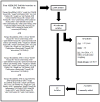Weight loss in obese adults 65years and older: a review of the controversy
- PMID: 23403042
- PMCID: PMC3714333
- DOI: 10.1016/j.exger.2013.02.005
Weight loss in obese adults 65years and older: a review of the controversy
Abstract
Obesity in older adults is ubiquitous in many developed countries and is related to various negative health outcomes, making it an important public health target for intervention. However, treatment approaches for obesity in older adults remain controversial due to concerns surrounding the difficulty of behavior change with advancing age, exacerbating the age-related loss of skeletal muscle and bone, and the feasibility of long-term weight maintenance and related health consequences. This review serves to systematically examine the evidence regarding weight loss interventions with a focus on obese (body mass index 30kg/m(2) and above) older adults (aged 65years and older) and some proposed mechanisms associated with exercise and caloric restriction (lifestyle intervention). Our findings indicate that healthy weight loss in this age group can be achieved through lifestyle interventions of up to a one-year period. Most interventions reviewed reported a loss of lean body mass and bone mineral density with weight loss. Paradoxically muscle quality and physical function improved. Inflammatory molecules and metabolic markers also improved, although the independent and additive effects of exercise and weight loss on these pathways are poorly understood. Using our review inclusion criteria, only one small pilot study investigating long-term weight maintenance and associated health implications was found in the literature. Future research on lifestyle interventions for obese older adults should address the loss of bone and lean body mass, inflammatory mechanisms, and include sufficient follow-up to assess long-term weight maintenance and health outcomes.
Keywords: Lifestyle intervention; Obesity; Older adults; Weight loss; Weight maintenance.
Copyright © 2013 Elsevier Inc. All rights reserved.
Conflict of interest statement
The authors declare no conflict of interests.
Figures


References
-
- Anandacoomarasamy A, Fransen M, March L. Obesity and the musculosketal system. Curr Opin Rheumatol. 2009;21:71–77. - PubMed
-
- Bales CW, Buhr G. Is obesity bad for older persons? A systematic review of the pros and cons of weight reduction in later life. JAMDA. 2008;9:302–312. - PubMed
-
- Binder EF, Schechtman KB, Ehsani AA, Steger MK, Brown M, Sinacore DR, Yarasheski KE, Holloszy JO. Effects of exercise training on frailty in community-dwelling older adults: results of a randomized controlled trial. J Am Geriatr Soc. 2002;50:1921–1928. - PubMed
-
- Brown M, Sinacore DR, Binder EF, Kohrt WM. Physical and performance measures for the identification of mild to moderate frailty. J Gerontol A Biol Sci Med Sci. 2000;55:M350–355. - PubMed
Publication types
MeSH terms
Grants and funding
LinkOut - more resources
Full Text Sources
Other Literature Sources
Medical

